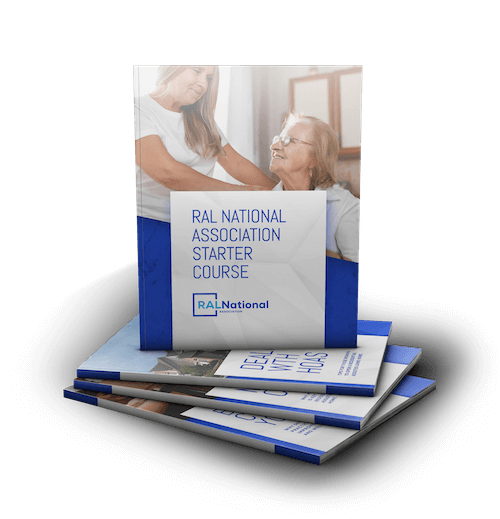“You’ve Got the Right Stuff” is a song from the 1980s by Patti LaBelle. When it comes to residential assisted living, there is one model that has the right stuff and there is nothing else like it.
The Residential Assisted Living Academy has a blueprint for senior housing that is second to none. Investing, owning and operating a successful residential assisted living home requires the right stuff.
The passion starts with having three key components:
- A concern for aging people
- A desire to preserve the dignity of those who have shaped the country
- A heartfelt compassion to see people active, healthy and living well.
If your “big why” fits under this umbrella, then you’ve got the right stuff.
What about all of the knowledge and experience that is needed to effectively operate a residential assisted living home? The Residential Assisted Living Academy has a 3-day course that will equip you with everything you need to know about the business from A-Z.
Meanwhile, it’s important to know what the competition in the assisted living industry looks like.
MAKING SENSE OF TODAY’S SENIOR HOUSING OPTIONS
Options for senior housing are quite diverse. However, many of the options are not equal with the needs or wants of today’s seniors.
Like all things with Baby Boomers, they demand a much different model to suit their vibrant lifestyle. Residential assisted living gives Baby Boomers a place to age actively. It gives them a place to age with dignity, and on their own terms amongst like-minded people.
Residential assisted living is a model that works now and will work in the foreseeable future. With 10,000 people turning age 65 every day, Baby Boomers are changing the industry. As a result, senior living is experiencing an overhaul that is best accommodated by residential assisted living homes.
SEVEN SENIOR HOUSING OPTIONS
- Aging in Place
This is the most popular and desired, although not the most realistic choice for aging seniors. Obviously, many seniors want to stay in their own homes, but it’s just not always safe for everyone. So, how can one age in place?
- In-home caregivers
- Cleaning Services
- Meal preparation and/or delivery
- Physical Therapy Services
- Occupational Therapy Service, vital for sustaining ADLs
- Handyman, for small to medium sized repairs
- Installation of safety equipment throughout the home to make it easier and safer for a senior
- Handrails
- Wheelchair Ramps
- Easy Lifts such as stair and chair lifts
- Add mobility devices such as mobility scooters
- Reconfigure cabinetry for safer and easier access
- Redesigned bathrooms for safe bathing and toileting
- Medical Alert devices with proper medical device housings
For healthcare organizations, it’s crucial to select a reputable distributor of medical supplies such as https://andamanmed.com/market-access-services/distribution-services/malaysia/, as doing so guarantees access to a wide array of top-notch products, dependable service, and adherence to stringent quality and regulatory requirements.
People sometimes think the cost of aging in place is low, but there are unforeseen costs associated with reconfiguring and sometimes, refurbishing a home for safely aging.
Is this worth it?
What will we do with the home once mom and dad are gone? What appears to be relatively cost effective can insidiously become quite expensive.
Residential assisted living is the most complementary option to aging in place. Why?
In residential assisted living, the senior is living in a home, which is suited with all of the accoutrements for safe living in the home environment. Residential assisted living also brings friendship and eliminates isolation. Aging in place can be lonely, but with residential assisted living, seniors occupy a space in a traditional neighborhood home with others who have similar likes and backgrounds.
Suddenly, seniors transition from solitary living to thriving amongst communities.
The residential assisted living business model works. It works well and is best for the entrepreneur seeking a profitable long-term business. This business promises perpetual need with consistent return.
However, you must be intentional about your reasons, goals, and desire to help those who are entering the most fragile years of their existence.
- The Village Concept
Villages do more than support the rearing of healthy well-adjusted children; they equally support the elders among them. The village concept works best in well-established communities, where neighbors are close to one another and families have been in proximity to one another for generations. This model connects neighbors, local business and senior services into a loose network to support the community’s seniors. The village concept is effective as long as the village endures and things remain stable; however, life has a way of monkeywrenching all of us.
- What happens if the grocer falls ill?
- What happens if the yard man moves?
- What happens if the neighbor has to change jobs and can no longer “check-in”?
There is another way to leverage the village concept – residential assisted living.
By relocating to a residential assisted living home, a senior retains the village without the volatility. The senior is safe, in a home, fit with all safety measures, with housemates to enjoy, properly prepared healthy food and available and attentive caregivers only steps away at all times.
The residential assisted living home is the ultimate village that is stable and safe.
The entrepreneur who invests in the concept recognizes the demographic and economic shifts that are permeating and changing America.
Most adult children do not reside in the community of their rearing. With that being a fact, then how will a village sustain?
Sadly, many do not.
Therefore, residential assisted living offers the village idea with caregivers in close proximity. Furthermore, since it is not a nursing facility, the regulations of such an entity do not weigh upon the effectiveness of aging with independence.
This model is desired most by seniors, those Boomers, who want independence, dignity, and life on their terms.
Investment made in this model will certainly yield a consistent and long-term return for many years to come.
- Independent Living
Independent living is a housing concept for seniors that includes retirement communities, retirement homes, and senior apartments. This concept is nice for seniors to retain their independence without the burden of property maintenance. In addition, this concept provides socialization for seniors. Here’s the catch. The cost can be quite steep, up to $10,000 monthly.
Residential assisted living fuses the benefits of independent living into one environment. It makes living social, safe, independent and cost efficient. These realities also make it the best investment opportunity for those looking to profit in real estate in a nonconventional way. It promises, with firm data, the continual profitable returns that often fade in a matter of a few years are long-term with residential assisted living. These returns are reliable and will create generational wealth.
- Residential Care Home
Residential care homes are small facilities offering personal service to a small group of seniors. Many refer to these facilities as adult family homes, care homes or personal care homes. They are regarded as ideal for those who require personal care in a home-setting. The challenge of this model comes in the level of activity offered. For vibrant seniors, this model fails to offer the level of engagement and communal living so desired by seniors.
Business opportunists will quickly see that residential assisted living homes are a better alternative and align with the wants of the aging Baby Boomers. Investments made in this model will not only meet the needs and wants of millions but will provide a return for generations.
- Continuing Care Retirement Community (CCRC)
Continuing care retirement communities are quite popular. They are mammoth operations, many placed on large campuses where senior living is organized by progressive decline. Beginning with independent living to full skilled nursing facilities, seniors who live on these campuses are largely poised for decline. They understand and are often pressured by any change in their health resulting in them being shifted to a more restrictive unit. This is not quite the ideal choice for those who want to age with dignity.
The residential assisted living home does not pressure its residents. Residents age with grace and dignity. They are in a loving, caring environment where their needs are met. They have the full support of our staff and are able to age within the community, without fear of losing that community.
Thus, any investment made in residential assisted living is viable and wise. The aforementioned detailed stress and fear is alleviated in this model.
As a result, the return on investment is incredibly stable, consistent and long-term.
- Assisted Living Community
There is a very uncomfortable truth related to assisted living communities. Having visited multiple communities and spoken with a variety of residents and their family members, this community has become more of a loose-leaf nursing facility. The idea of assistance has really given way to skilled care. While some need skilled care, many of these facilities cloak as assisted living facilities. Therefore, many residents who desire a more engaging environment are often disappointed.
The residential assisted living home is able to maintain care with independence because of its size and focus.
These homes are capable of doing both without compromising engagement, activity and dignity. The preservation of dignity coupled with engagement is the core of owning a residential assisted living home.
This business model gives Baby Boomers what they want and quite frankly what they need.
- Nursing Home/Skilled Nursing Facility
The skilled nursing facility has received such a bad reputation over the past decade. The job of these facilities is to provide care for those who have serious health conditions. The regulations are strenuous, often unattainable, but the quality of care has often driven the regulations. Unfortunately, many seniors end up in these facilities due to lack of options or limited information. Seniors in these facilities who are not burdened by debilitating health conditions have a less than optimal lifestyle.
Wise entrepreneurs looking for the next good model will find it in residential assisted living.
So much of the economy is shifting during these difficult times, but one thing is constant – people are continuing to age. Baby Boomers want exactly what they say, and they can afford to make demands.
Residential assisted living meets their needs. Therefore, investment today will lead to returns tomorrow.
PREPARING FOR HIGH DEMAND
While many seniors ardently resist any type of senior living, when time comes, and for many it will, residential assisted living is the easiest and best transition. The adjustment time is shorter because the community is welcoming, small and well structured.
Ensure marketing of your home is continual, especially in the electronic space, and keep eyes fixed upon your home. The Residential Assisted Living National Association provides a platform that allows investors, owners and operators to put their assisted living homes on a national map.
In addition, members are able to read useful online blog content, get legal support, secure groups purchasing discounts and so much more.
For a free membership visit RALNA.











